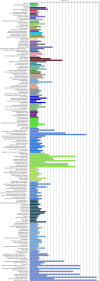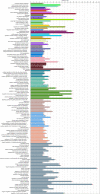Analysis of dog breed diversity using a composite selection index
- PMID: 36717599
- PMCID: PMC9886904
- DOI: 10.1038/s41598-023-28826-3
Analysis of dog breed diversity using a composite selection index
Abstract
During breed development, domestic dogs have undergone genetic bottlenecks and sustained selective pressures, as a result distinctive genomic diversity occurs to varying degrees within and between breed groups. This diversity can be identified using standard methods or combinations of these methods. This study explored the application of a combined selection index, composite selection signals (CSS), derived from multiple methods to an existing genotype dataset from three breed groups developed in distinct regions of Asia: Qinghai-Tibet plateau dogs (adapted to living at altitude), Xi dogs (with superior running ability) and Mountain hounds (used for hunting ability). The CSS analysis confirmed top ranked genomic regions on CFA10 and CFA21 in Qinghai-Tibet plateau dogs, CFA1 in Xi dogs and CFA5 in Mountain hounds. CSS analysis identified additional significant genomic regions in each group, defined by a total of 1,397, 1,475 and 1,675 significant SNPs in the Qinghai-Tibetan Plateau dogs, Xi dogs and Mountain hounds, respectively. Chitinase 3 Like 1 (CHI3L1) and Leucine Rich Repeat Containing G Protein-Coupled Receptor 6 (LGR6) genes were located in the top ranked region on CFA7 (0.02-1 Mb) in the Qinghai-Tibetan Plateau dogs. Both genes have been associated with hypoxia responses or altitude adaptation in humans. For the Xi dogs, the top ranked region on CFA25 contained the Transient Receptor Potential Cation Channel Subfamily C Member 4 (TRPC4) gene. This calcium channel is important for optimal muscle performance during exercise. The outstanding signals in the Mountain dogs were on CFA5 with 213 significant SNPs that spanned genes involved in cardiac development, sight and generation of biochemical energy. These findings support the use of the combined index approach for identifying novel regions of genome diversity in dogs. As with other methods, the results do not prove causal links between these regions and phenotypes, but they may assist in focusing future studies that seek to identify functional pathways that contribute to breed diversity.
© 2023. The Author(s).
Conflict of interest statement
The authors declare no competing interests.
Figures






References
-
- Club AK. The Complete Dog Book. 20. Random House Publishing Group; 2007.
-
- American Kennel Club, <https://www.akc.org/> (2022).
-
- Australian National Kennel, C. Illustrated breed standards / Australian National Kennel Council. (Royal NSW Canine Council], 1998).
-
- Dogs Australia, <https://dogsaustralia.org.au/> (2022).
Publication types
MeSH terms
LinkOut - more resources
Full Text Sources
Research Materials
Miscellaneous

